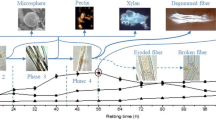Abstract
Coir fiber belongs to the group of hard structural fibers obtained from coconut husk. As lignin is the main constituent of coir responsible for its stiffness, microbes that selectively remove lignin without loss of appreciable amounts of cellulose are extremely attractive in biosoftening. Five isolated strains were compared with known strains of bacteria and fungi. The raw fiber treated with Pseudomonas putida and Phanerocheate chrysosporium produced better softened fiber at 30±2 °C and neutral pH. FeSO4 and humic acid were found to be the best inducers for P. chrysosporium and P. putida, respectively, while sucrose and dextrose were the best C-sources for both. Biosoftening of unretted coir fibers was more advantageous than the retted fibers. Unlike the weak chemically softened fiber, microbial treatment produced soft, whiter fibers having better tensile strength and elongation (44.6–44.8%) properties. Scanning electron microscopy photos showed the mycelia penetrating the pores of the fiber, removing the tylose plug and degrading lignin.








Similar content being viewed by others
References
Bhat JV, Nambudiri AMD (1971) The uniquity of coir retting. J Sci Ind Res 30:17–28
Thampan PK (1975) The coconut palm and its products. Greenvilla Publishing House, Kerala, pp 268–281
Menon SRK (1936) The chemistry of coir fibre. J Text Inst 27:229
Blanchette RA (1984) Screening wood decayed by white rot fungi for preferential lignin degradation. Appl Environ Microbiol 48:647–653
Haider K, Trojanowski J, Sundman V (1978) Screening for lignin degrading bacteria by means of 14C-labelled lignins. Arch Microbiol 119:103–106
Gradziel K, Haider K, Kochmanska J, Malarczyk E, Trojanowski J (1978) Bacterial decomposition of synthetic 14C-labeled lignin and lignin monomer derivatives. Acta Microbiol Pol 27:103–109
Glenn JK, Gold MH (1983) Decolourization of several polymeric dyes by the lignin degrading basidiomycete Phanerochaete chrysosporium. Appl Environ Microbiol 45:1741–1747
Kuwahara M, Glenn JK, Morgan MA, Gold MH (1984) Separation and characterization of two extracellular H2O2-dependent oxidases from ligninolytic cultures of Phanerochaete chrysosporium. FEBS Lett 169:247–250
Kirsten PJ, Kirk TK (1987) Involvement of a new enzyme, glyoxal oxidase, in extracellular H2O2 production by Phanerochaete chrysosporium. J Bacteriol 169:2195–2201
Kelley RL, Reddy CA (1986) Purification and characterization of glucose oxidase from ligninolytic cultures of Phanerochaete chrysosporium. J Bacteriol 166(1):269–74
Volc J, Eriksson KE (1988) Pyranose 2-oxidase from Phanerochaete chrysosporium. Methods Enzymol 161:316–322
Bourbonnais R, Paice MG (1988) Veratryl alcohol oxidases from the lignin-degrading basidiomycete Pleurotus sajor-caju. Biochem J 255:445–450
Orth AB, Royse DJ, Tien M (1993) Ubiquity of lignin-degrading peroxidases among various wood-degrading fungi. Appl Environ Microbiol 59:4017–4023
Hatakka A (1994) Lignin-modifying enzymes from selected white rot fungi—production and role in lignin degradation. FEMS Microbiol Rev 13:125–135
Sakurai A, Yamamoto T, Makabe A, Kinoshita S, Sakakibara M (2001) Removal of lignin - a liquid system by an isolated fungus. J Chem Technol Biotechnol 77:9–14
Sirianuntapiboon S, Sihanonth P, Somachai P, Atthanasampunna P, Hayashida S (1995) An absorption mechanism for the decolourization of melanoidin by Rhizoctonia sp. D-90. Biosci Biotechnol Biochem 59:1185–1189
Pandalai KM, Nair UK, Menon KPV (1957) A note on the quality in relation to the retting of coconut husks. Coir 1(3):30
Vogel HJ (1956) A convenient growth medium for Neurospora crassa. Genet Bull 13:42–43
Vares T, Kalsi M, Hatakka A (1995) Lignin peroxidases, manganese peroxidases, and other ligninolytic enzymes produced by Phlebia radiata during solid-state fermentation of wheat straw. J Appl Environ Microbiol 61(10):3515–3520
Tien M, Kirk TK (1984) Lignin-degrading enzyme from Phanerochaete chrysosporium: purification, characterization, and catalytic properties of a unique H2O2-requiring oxygenase. Proc Natl Acad Sci 81:2280–2284
Prasad SV, Pavithran C, Rohatgi PK (1983) Alkali treatment of coir fibers for coir–polyester composites. J Mater Sci 18:1443–1454
Kirk TK, Connors WJ, Zeikus JG (1976) Requirement for a growth substrate during lignin decomposition by two wood rotting fungi. Appl Environ Microbiol 32:192–194
Jeffries TW, Choi S, Kirk TK (1981) Nutritional regulation of lignin degradation by Phanerochaete chrysosporium. Appl Environ Microbiol 42:290–296
Ulmer D, Leisola M, Puhakka J, Fiechter A (1983) Phanerochaete chrysosporium: growth pattern and lignin degradation. Eur J Appl Microbiol Biotechnol 18:153–157
Leisola M, Ulmer D, Haltmeier T, Fiechter A (1983) Rapid solubilization and depolymerization of purified Kraft lignin by thin layers of Phanerochaete chrysosporium. Eur J Appl Microbiol Biotechnol 17:117–120
Orth AB, Royse DJ, Tien M (1993) Ubiquity of lignin-degrading peroxidases among various wood-degrading fungi. Appl Environ Microbiol 59:4017–4023
Reid ID, Paice MG (1998) Effects of manganese peroxidase on residual lignin of softwood kraft pulp. Appl Environ Microbiol 64(6):2273–2274
Ander P, Eriksson KE (1975) Influence of carbohydrates on the lignin degradation of white rot fungus Sporotrichum pulverulentum. Svensk Paperstidn 78:643–652
Kirk TK, Fenn P (1982) Formation and action of the ligninolytic system in basidiomycetes. Cambridge University Press, Cambridge, pp 67–90
Kirk TK, Schultz E, Connors WJ, Lorenz LF, Zeikus JG (1978) Influence of cultural parameters on lignin metabolism by Phanerochaete chrysosporium. Arch Microbiol 117:277–285
Acknowledgments
The authors acknowledge Director of Regional Research Laboratory for providing the necessary facility to carry out the work. Prof. Peter Koshy is thanked for SEM pictures.
Author information
Authors and Affiliations
Corresponding author
Rights and permissions
About this article
Cite this article
Rajan, A., Senan, R.C., Pavithran, C. et al. Biosoftening of coir fiber using selected microorganisms. Bioprocess Biosyst Eng 28, 165–173 (2005). https://doi.org/10.1007/s00449-005-0023-2
Received:
Accepted:
Published:
Issue Date:
DOI: https://doi.org/10.1007/s00449-005-0023-2




